#very much like the classic portrayal of knights as lovers
Explore tagged Tumblr posts
Text
knight!reo or knight!barou 🎤 who is more devoted
#the knight disease in my brain came to take me tonight#LOOK ………….#knight!barou would be. sooo ferocious#so so scary#definition of a chained dog#but i do think he is loyal only to you .#and because of that his loyalty is just . insanely weighty#knight!reo on the other hand ……..#he is in it#For Love .#very much like the classic portrayal of knights as lovers#reo is . the lover of a queen with a neglectful husband#<- something like that . etcetc#it’s about passion to him ……….#will do anything to stay by your side#barou is more of an attack dog and reo is more of a guard dog . maybe#overall i think barou is the better knight but reo is more likely to give up anything for you ….#probably ?#bllk moots what do u think#ari noises ✩
19 notes
·
View notes
Text
The Most Common Types of Cinderella in "Cinderella" Adaptations
After reading @ariel-seagull-wings's great post about the most common portrayals of Cinderella's Prince, I thought I'd take a similar look at the different versions of Cinderella herself. As with the Prince, we've seen very different portrayals over the years to suit each time and place's ideals of what a fairy tale heroine should be like, and while each one is unique, certain patterns do reappear. These are the six most common Cinderellas in my experience.
The Waif

This is the most traditional Cinderella – the type seen in virtually every adaptation until the 1950s. She's a very young, innocent, fragile girl, and her rags are especially ragged and smudged with ashes. In effect, she's like an older version of little Cosette from Les Misérables. She lives in terror of her Stepmother, quaking at any sign of anger from her, and is often implied to not just be insulted and forced to serve, but physically abused. And though she tries to be content with only her dreams and accept her hard life without complaining, she's still a deeply melancholy little figure. She can often be found sitting by the fire and singing a wistful folk tune. The audience wants to rescue her, and so does the Prince after her innocent, artless demeanor, her instinctive kindness, and her natural grace and beauty win his heart. Standout Cinderellas of this type include those from the two classic opera adaptations, Rossini's La Cenerentola and Massenet's Cendrillon, as well as those from the two Russian film versions (the 1947 live-action film and its 1979 animated remake), and Lesley Ann Warren in the 1965 version of Rodgers and Hammerstein's musical.
The Girl Next Door
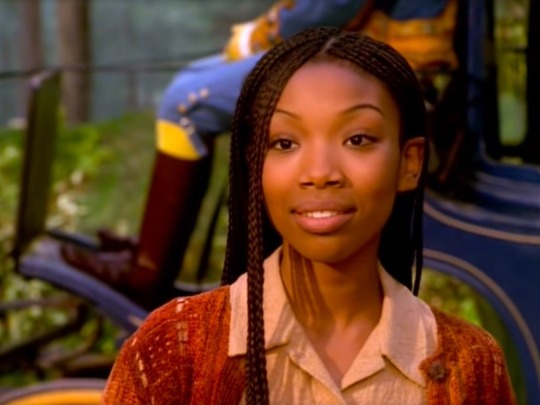
Like "the Waif," this Cinderella is very young, sweet, innocent, and vulnerable, but she's less battered and melancholy. She's capable of quietly standing up to her stepfamily, or at least trying to, and capable in lighter moments of being playful and clever, with a gentle sense of humor. Her Prince tends to be as much of a friend as a lover to her, bonding with her over shared dreams and longings, and seeing her as a someone he can "really talk to" as an equal. She's also more likely than other Cinderellas to have a real character arc, struggling with fears and self-doubt at first, but ultimately growing in self-respect and inner strength, and realizing that even in rags she's worthy of her Prince's love. She's clearly not just meant to be touching, or just a role model, but a person whom the average young viewer can identify with. Brandy Norwood's 1997 Rodgers and Hammerstein Cinderella is of this type; so is the heroine of the 1996 anime Cinderella Monogatari, Jennifer Beals in the Cinderella episode of Faerie Tale Theatre, and Emilia Schüle in the the German anthology Märchenperlen.
The Idealist
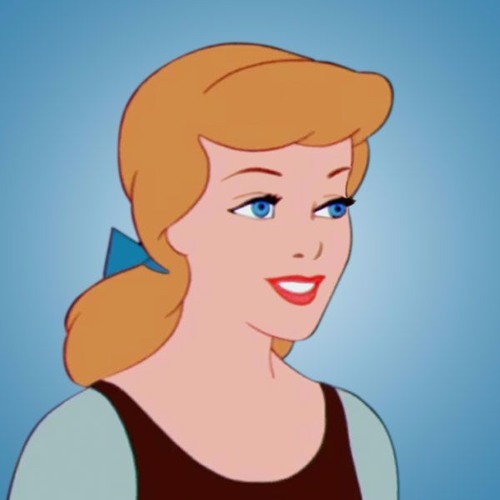
This Cinderella comes across as more mature than the first two: a young woman, not a girl. Even in her rags, she's as neat, clean, and well-put-together as her hard work allows, and from the start she has an air of dignity, clearly having been taught to be a proper lady by her parents before they died. She usually has a sunny, cheerful disposition too, although like every other Cinderella she has moments of despair. At the core of all this is a profound idealism, just as staunch as Don Quixote's: a vision of who she wants to be and what she wants to believe, which she follows like a graceful lady knight on a quest. The word that best describes what she does is "maintaining": in the face of all hardship, maintaining her cheerfulness, her dignity, her kindness, and her faith in her dreams of future happiness. The classic idealist Cinderella is the Disney Cinderella, both in her 1950 animated form and in Lily James's 2015 portrayal, while another example is Julie Andrews in the Rodgers and Hammerstein's musical's original 1957 version.
The Tomboy
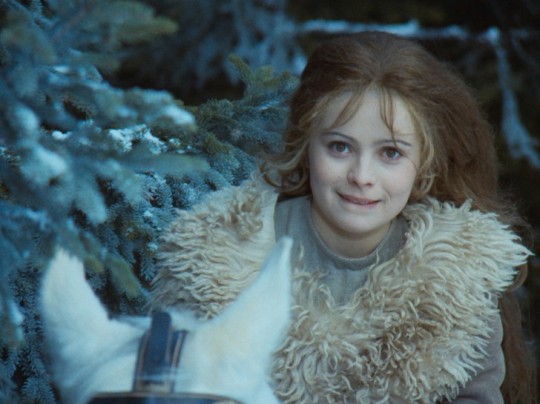
This Cinderella is more of a gamine than a waif; more of an Éponine than a Cosette. She puts up with her stepfamily's abuse because otherwise she would be homeless, but she handles it with a feisty attitude, sassing back when they insult her and standing up to them with real rage when they push her too far. When she's not working, her preferred escape is into a forest or some other wild place, where she can ride a horse, climb trees, swim in a river, or just be free. The Prince is usually drawn more to her strength of will, her passion, and/or her sarcastic wit than he is to her beauty. A subtype of this Cinderella is the gritty outcast: an angry, unsociable girl who wears her grimy, unfeminine looks with pride and masks her pain with rudeness, until a kind, perceptive Prince sees the princess within her. Cinderellas of that subtype are Leslie Caron's Ella in 1955's The Glass Slipper and the anti-heroine of Andrew Lloyd Webber's 2021 musical. Meanwhile, more conventionally charming tomboy Cinderellas are Libuše Šafránková in the Czech cult classic Three Wishes for Cinderella, Christianne Tisdale in the lesser-known musical A Tale of Cinderella, Aylin Tezel in the German anthology Sechs auf einen Streich (who skirts the edge between "the Tomboy" and "the Girl Next Door"), and Drew Barrymore's Danielle in the 1998 classic Ever After: A Cinderella Story... although she combines this with a different variation of the character, outlined below.
The Activist

This Cinderella's hard life has made her an advocate for others who are abused or oppressed. Whether these others are the kingdom's ordinary poor and working classes or magical creatures who face discrimination from humans, she'll do all she can to help them, even if it means getting into trouble with authorities. You can expect her to be more intellectual than other Cinderellas, to be a lover of socio-political books, and to be close friends with fellow servants, beggars, or even revolutionaries. She also tends to have a low opinion of the Prince at first, as he starts out as either a bit of a snob or else too sheltered and blind to social injustice; their romance arc revolves largely around her teaching him to be a better future king. Without a doubt, this Cinderella will be a an outstanding queen who improves her subjects' lives. As far as I know, this characterization first appeared in Ever After: A Cinderella Story, where Drew Barrymore's Danielle combines it with "the Tomboy"; in her footsteps followed Anne Hathaway's Ella in the 2004 film version of Ella Enchanted, and the Cinderella of the 2013 Broadway version of Rodgers and Hammerstein's musical.
The Artist
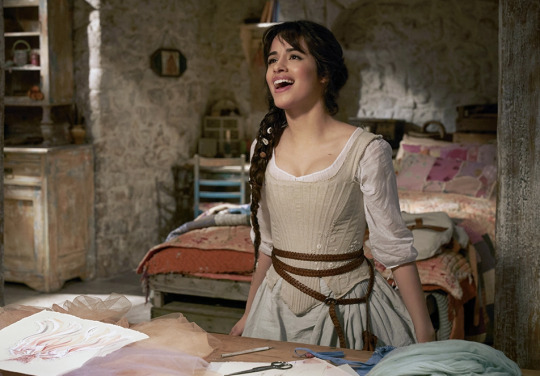
This version of Cinderella has a special talent that she wants to share with the world. Maybe it's fashion design, like in the 2021 Sony/Amazon film; maybe it's composing music, like in Alma Deutscher's opera; or maybe she's an inventor, like in Betsy Cornwell's YA novel Mechanica. Hardly anyone knows or appreciates her work, but every moment she can spare from housework is spent pouring her heart and soul into her talent. Her dream is to use it to earn an independent living, free from her Stepmother, who will stop at nothing to thwart that dream. The Prince in this version helps to support Cinderella's work, either at the ball or beforehand, and her main reason for going to the ball is to showcase her artistry. Of all the Cinderellas, this one most typically doesn't become the future queen in the end, because her ideal ending is to gain fame and fortune from her talent. If the responsibilities of the crown would interfere with her goals, then either the Prince abdicates his throne to be with her, or else they decide they're better as friends than as a couple.
Which type of Cinderella is your favorite? Or what do you like best about each one?
@ariel-seagull-wings, @faintingheroine, @superkingofpriderock, @the-blue-fairie, @themousefromfantasyland, @storytellergirl
#cinderella#fairy tale#adaptations#characterization#comparison#character types#patterns#fictional characters
208 notes
·
View notes
Text
Early Modern Drama Rec List (Non-Shakespeare)
So I just spend a year reading a lot of early modern drama and I thought I might as well put my degree to a good use and make a list of some of my favourite lesser known (i.e. not written by Shakespeare) early modern plays. All of these plays are in the public domain, so it should be very easy to find them online.
Comedies:
The Roaring Girl by Thomas Middleton and Thomas Dekker - a fictional story featuring a dramatized portrayal of a real person, Mary Firth, also known as Moll Cutpurse. Moll was a notorious pickpocket, wore a doublet and breeches, smoked a pipe, cursed, and was generally infamous for her 'mannish' behaviour. And she's a character in this play!
It is open to interpretation how positive the play's depiction of Moll really is, but she does play a very important role in getting the main pair of lovers together and ends the play happily continuing to live her life the way she wants, which is in itself pretty incredible. Overall, just a really fun read.
Galatea (or Gallathea) by John Lyly - a 16th century play that is both gay and trans??? Sign me up! In a village where the fairest virgin needs to be sacrificed to Neptune every 5 years (or he'll drown everyone), two fathers decide to disguise their beautiful daughters as boys and hide them in a nearby forest. While wandering around the forest the two girls meet and, falling for each other's disguises, fall in love. In the end (spoilers for the ending, but this is not exactly a play you read for the plot, lol), Diana stops Neptune, the two girls find out each other's true identities and decide they're still in love, and Venus turns one of them (we never find out which one) into a boy so that they can get married.
As must be clear from this summary, this comedy plays around with gender a lot. To add to the gender cocktail, remember that the two girls would have been originally played by boys. Although the ending was seen as heteronormative by early queer critics, the emergence of trans criticism within queer theory has led to a lot of interesting readings of the play. Well worth a read.
(also, if you have a device on which you can play DVDs and some money to spare, consider buying a DVD of the Edward's Boys production of the play. Edward's Boys is a group that replicates the format of early modern boys' companies, with all roles in their productions being played by boys. I will admit, when I bought a DVD of their 2014 production of Galatea, I expected to watch a glorified high school performance, but it turned out to be so good. All the boy actors were amazing, way better at performing Shakespeare than a lot of Hollywood actors. This just straight-up felt like a professional theatre production, I highly recommend it.)
The Knight of the Burning Pestle by Francis Beaumont - I don't even know how to describe this play other than 'fantastic and fun'. A meta-theatrical city comedy, which starts with a pair of audience members (who were actually two dressed-up boy actors from the boys' company performing the play) jumping onto a stage and demanding to see a different play than the the one being set up. Things get only wilder from there.
A genuinely really funny play. I don't know of anyone who has read it and hasn't immediately loved it.
The Sea Voyage by John Fletcher and Philip Massinger - one of the least well known plays out of this list, which is unfortunate because this play is really fun. Short and sweet, it's a story of a bunch of (surprisingly honorable) pirates, who get shipwrecked on an island inhabited by a tribe of Amazon-like women. Predictably, hijinks ensue. An interesting look into early modern gender relations (apparently the main reason why living without men would be difficult for women is because of how horny they would get? I think Fletcher and Massinger need to take a lesson or two from Lyly).
The Alchemist by Ben Jonson - want to see three assholes con a bunch of idiots in increasingly ridiculous ways? Then this is the play for you.
Jonson's city comedies, which satirize the people of early modern London, tend to be much meaner in tone than Shakespeare's comedies and the other comedies on this list, but in many ways, that's what makes them fun. Viciously clever and at times really funny, there's an edge to the writing that makes it very entertaining. I had a lot of fun reading this (Jonson's Epicoene is also great, if you want a comedy that's even meaner and also has some very questionable gay stuff in it).
Tragedies:
Doctor Faustus by Christopher Marlowe - probably the most famous non-Shakespeare early modern play, and for a good reason. It has everything; pacts with the devil, a melodramatic anti-hero protagonist, homoeroticism (I mean of course, it's Marlowe), and a suitably gory and tragic ending. What more can you ask for?
The Tragedy of Mariam by Elizabeth Cary - this play is more interesting than fun, but I think it's still well worth a read. It's the first original play written in English by a woman. The play takes place in ancient Palestine. It looks at the way Mariam, a Jewish queen, reacts to the news of the death of her husband, the tyrannous Herod (yes, the baby-killing guy from the Bible). Most people seem to be relieved. Except oops, Herod is not actually dead.
A fascinating look at gender ideology in the early modern period, with the play centering around the conflict of a woman who tries to live up to the ideals of a perfect wife and woman, while stuck in a marriage to a tyrant. This play would also be a great read for anyone interested in how gender and sexuality intersected with race in early modern England, because this play uses a lot of racialized language to describe women.
The Duchess of Malfi by John Webster - a classic revenge tragedy. A recently widowed Duchess wants to marry her steward, but her asshole brothers throw a fit. Intrigue and death ensue. At one point a fake wax hand and some fake wax corpses appear on stage.
This play basically reads like a good thriller. Fucked up in a way that only an early modern revenge tragedy can be, this is a fun and thrilling read.
The Changeling by Thomas Middleton and William Rowley - speaking of fucked up. If you're planning to read it, be mindful that this play contains sexual assault. It's a story of a young noblewoman called Beatrice, who wants to get rid of her fiancé after falling in love with a visiting nobleman. To do it, she enlists the help of her villainous servant De Flores. Things end up going extremely badly.
This play can get very uncomfortable at times, but just like The Duchess, it's as gripping as any good modern thriller. Very engaging. The ending is as engrossing as it is stomach-churning, although probably not for the reasons it was originally meant to (reading criticism about The Changeling, it is genuinely shocking and disheartening to see how long it took for critics to start addressing the clear issues of consent in the play). The story also includes a bizarre virginity test that uses a potion which makes you drowsy or which makes you sneeze and laugh depending on whether you had sex or not, so hey, at least that's fun?
Antonio's Revenge by John Marston - ok, so this is definitely the least... good of the plays I've recommended so far, but listen. Do you like trainwrecks? Do you like violence so over-the-top that people to this day wonder whether it's actually supposed to be a parody of the revenge tragedy genre? Are you looking for a reading experience that will make you go 'what the fuck' throughout? If so, this is the play for you!
Very much in the so bad it's good category. Ridiculously gory. The only thing that makes it better is knowing that it was originally played by children (on a related note, I haven't seen this production, but I know that this play has also been played by Edward's Boys). If you like horrible, gory horror movies, you'll probably enjoy this play.
That's it for now! Hopefully at least a few of these plays catch your interest.
Btw, LibriVox, which is an organisation that makes public domain recordings of public domain texts, has most of these plays available as free audiobooks, if you're interested!
#early modern drama#early modern england#book rec#i don't know how else to tag this#i keep spending way too much time on these extremely niche posts#but hey i had fun writing this and maybe it'll end up being useful to someone who knows#alex's boring history corner#kind of???#shakespeare
25 notes
·
View notes
Text
Anti-blackness in 19th century England, why Queen Charlotte wasn’t black, and why it doesn’t matter in Bridgerton
I’d like to start by saying Bridgerton is a very amusing piece of absolute fiction. From the dresses to the music to the fanfic tropes it uses and the books it’s based on. It doesn’t even start to pretend it’s realistic. And being a piece of modern historical fantasy made by a woman born in this age, it is alright for the showrunners to give it a modern vibe. If you want, you can trace the lineage of every duke of Hastings there has ever been and know exactly who they were and what they looked like. Everyone knows there was never a black duke of Hastings, meaning there is no harm nor a deliberate attempt at “changing history” by the showrunners. They’re not pretending they’re portraying real events and real people of 1813. Therefore I accept that in this “alternative reality regency” it is fine for people of all ranks, including Queen Charlotte, to be black. I loved Golda Rosheuvel’s portrayal, I loved her looks, her acting and I tolerate her half-ishly accurate outdated wardrobe (for those interested in fashion history: look up “regency era court gowns”, old styles were worn but Charlotte would wear normal dresses day-to-day). I’m thrilled to watch her in the second season as well.
However, I will screech if I see people claiming Charlotte was black in real life. There were black people in Europe during all periods of history. They could be very influential and wealthy, and yes, they could even be nobility in some rare cases. There is a growing field of research tracing the steps of black people in Europe throughout time, revealing the often overlooked presence of black people. However, Queen Charlotte isn’t one of them. And I say this because claiming her to be black, would mean the British Monarchy, way ahead of its time, was accepting of black people. it would also mean the British people, who were more than a bit racist, generally accepted a (partially) black woman. Rather than Charlotte being black leading to her being described as black, I believe the confusion about her being black stems from people back in the day using racially ambiguous terms to make clear Charlotte looked ugly (because in a racist colonial world the best way to insult someone is by saying they look like a slave).
Being a historian, I do believe I have to give evidence for my claim. I’ll be using her ancestry, written descriptions and paintings. However, buckle up because you’ll be getting a lot of side information on other POC in art and literature. So if you’re interested in learning a bit about the relationship between the concepts of race and beauty in the 18th and 19th century, here we go. (note: if I use any offensive terms without direct citing someone, do let me know I will change them as soon as possible)
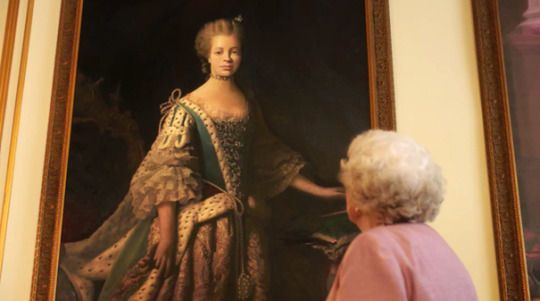
1. When did these rumours start
During the Regency Era, when the world was still a very colonial one, Queen Charlotte was described by some as having a big nose, full lips and an ambiguous complexion. However, her race was never debated, until academic discussions picked up around the 1940s.
2. Queen Charlotte’s family tree.
The Portuguese royal family definitely has Moorish blood in it. No one can contest that. Muslims and Europeans lived together on the Iberian Peninsula for 800 years. The question is whether that means that royals with a Portuguese ancestor can be called “people of colour”, and how far down the line people can still claim to be people of colour. Almost all royal households of Europe married into the Portuguese royal family at some point, yet of few royals it is said that because of that heritage, they are people of colour. That argument is only made for Queen Charlotte (imo that probably has a lot to do with the fact that the world is dominated by the Anglosaxon countries and that because of their worldwide tentacles and their language being the most universally spoken, the British Royal Family receives the most interest from everyone all over the world. Other royal families don’t get as much attention).
Note that I used the word people of colour, that is because the root of Charlotte’s supposed African heritage is not necessarily black. Let’s take a look at her family tree.
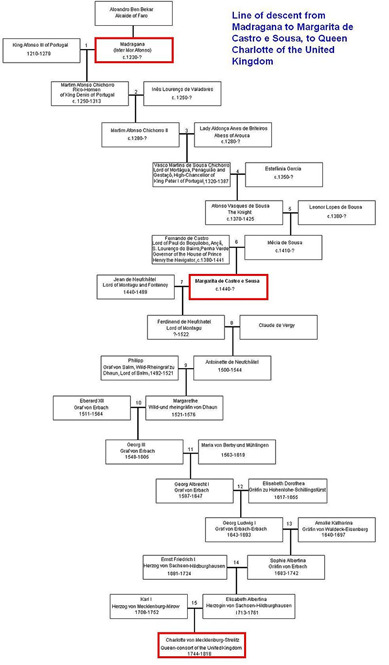
According to historian Mario de Valdes y Cocom — who dug into the queen’s lineage for a 1996 Frontline documentary on PBS — Queen Charlotte could trace her lineage back to black members of the Portuguese royal family. Charlotte was related to Margarita de Castro y Sousa, a 15th-century Portuguese noblewoman nine (!) generations removed.
Margarita de Castro e Souza herself descended from King Alfonso III of Portugal and his concubine, Madragana, a Moor that Alfonso III took as his lover after conquering the town of Faro in southern Portugal.
This would make Queen Charlotte a whopping 15 generations removed from her closest black ancestor — if Madragana was even black, which historians don’t know. That’s a lot of generations back. de Valdes y Cocom argues that, due to centuries-long inbreeding, he could trace six lines between Queen Charlotte and Sousa, which would mean Madragana’s genes were a bit more influential, but still 15 generations ago. That’s her grand-grand-grand-grand-grand-grand-grand-grand-grand-grand-grand-grandmother.
So, let’s pretend it is true and her ancestor was black, let me be very rude. An ancestor that appears once in a person's genealogy, fifteen generations removed, represents a 215-th fraction of its descendant's ancestry. Queen Charlotte’s black ancestry would be less than 1%. In fact it'd be 0.007% (rounded up) of Charlotte's ancestry, and that's IF Madragana could be proved to be Moorish. And if Moorish was only used to describe a black person. However, the use of “blackamoor” “moorish” and “mozaraab” are not an alternative word for black. Indeed, there is no definitive skin colour attached to these descriptors.
It is generally accepted that Spanish Moors were the Muslim Amazigh (formerly known as Berber) inhabitants of the Maghreb, a stretch of land in north-Africa including parts of the Sahara, but not Egypt. During the Middle Ages, they occupied the Iberian Peninsula and other parts of southern Europe, before being finally driven out in the 15th century. The greatest period of unity was probably during the period of the kingdom of Numidia. Over the centuries, the word came to acquire a plethora of other meanings, some of them derogatory. Importantly, it cannot be ascribed a single ethnicity. Moors are not always black, this is false. They remaining people in Africa can be anywhere from Arab, to black people. But I’m not delving into north-african migration patterns and population changes. In Europe, the moors could thus be Arab, black and often mixed ethnicity, the natural result of coexisting and intermarrying with white Europeans for centuries.
http://acaciatreebooks.com/blog/royalty-race-and-the-curious-case-of-queen-charlotte/
3. Gender, Race and beauty standards
The world of the 19th century was riddled with Anti-blackness. Part of this continued from the medieval belief that white was good, and dark was bad (see white knight, fair lady, black knight, dark magic notions that still persist today). It also does not help that during the Regency Era, Greek and Roman antiquity were very trendy. Although the old roman empire was a culturally and ethnically diverse society, regency people focussed on fashion, hairstyles and looks from the classical art period of Greece. People aspired to look like the statues: elegant, slim and dainty and wanted “noble” features (straight slim nose, even face, cheekbones, etc). That’s why in the regency era people were complimented for having “alabaster skin” or a “Grecian profile” and so on. These medieval notions of fairness and the grecian beauty ideal, were juxtaposed against the medieval notions of darkness combined with deeply colonial conceptions of womanhood and race. In a world in which white people controlled other ethnicities, race soon became a weapon, a tool to be used against someone. Just like… gender. And yes, you’ll soon see how these two go hand in hand.
Throughout the nineteenth century the domestic world and the public sphere became more and more separate, with women being given less space to move and work. All women had to be dainty housewives: refined, sensitive and docile, clever but not too well read. Of course, this was an unattainable standard for most women. Only women in the top layer of society were able to lounge around and do nothing all day. Many had to work. Many things of what women were supposed to be: pale, soft hands, were direct signs that they didn’t have to do manual labour (out in the sun, using their hands). Women who could not fit in that small domestic sphere were increasingly (especially later on in the Victorian era) seen as unfeminine and unworthy of husbands. Coarse, manly, unfeminine, unrefined they were often called. Welcome to 19th century “masculinity so fragile”. Just imagining a woman working or reading made men felt threatened. They hated the idea women weren’t just lounging around waiting to please them and provide for them. https://www.bl.uk/romantics-and-victorians/articles/gender-roles-in-the-19th-century# https://www.atlasobscura.com/articles/pit-brow-lasses-women-miners-victorian-britain-pants

Now look at this sketch of a female mine worker, one of many. Although the argument can be made she’s dark from the dirt, I want to point out that she’s also portrayed as scantily clad, wearing more manly clothes, being broader, wide of face and her hair appearing… quite curly.She’s the opposite of the beauty ideals, the opposite of what society wants a woman to be... and she’s suspiciously black-coded.
Pervasive and passive stereotypes of black people have come into existence since colonialism. Cruel caricatures of black people were omnipresent. Going as far as to ascribe them animal-like features with big mouths, big ears, sloping foreheads and so on. https://www.jstor.org/stable/2712263?seq=4#metadata_info_tab_contents
I could write a million essays on how race and sex have been weaponized in the past. When the “exploration travels” first started, and even much later in art, faraway lands were portrayed as sultry lazy or untamed women, waiting to be conquered and domesticated. Transforming countries into women was done to make them “controllable”. Portraying them as lazy and wild was a way Europeans to give themselves license to colonize them. Just like women at home, these foreign lands needed the guiding hand of cultured civilized men showing them how to do things and ruling them. So either men could control women which was perceived as good, or they couldn’t in which case the woman was looked down upon and hated. I don’t have an exact reference for this one, but it was a very interesting topic in my class on “Global History” at University. But for now this one carries a good part of the load.
https://www.ferris.edu/jimcrow/jezebel/
It is then no surprise the female black body became a site of seduction there for the white male’s taking. They literally became their property as slaves, just like a man’s wife was considered his property. White men sexualized black people, particularly black women, a stereotype that perpetuates to this day and age. See the link above for that as well. Black women became temptresses.
White women, of course, didn’t like that. They wanted their men to be theirs. So these 19th century Karens started hating them as well. These wild temptresses were out to catch their men with their “foreign looks”. Meanwhile white men hated the idea of white women being seduced by black men. And this, combined with the resentment for working class women, gave way to a kind of language people used to describe each other. All stereotypes (medieval+ working class women looks+ black looks) were stacked atop each other: dark, tempting, coarse, black, plump, uncivilized, wild, broad-faced, thick of lip… Hair didn’t much come into play in the 18th century since most people of high society wore wigs (which in paintings can look like type 4 hair but cannot be used as an indicator of race) but afterwards “tight coils” was also added to the list of features that weren’t deemed desirable. This physical robustness not only lies in the idea that people who work are “hardened” but by describing them with strong robust adjectives, upper class white people once again fuel the idea that these people were physiologically designed for hard work, like slave labour or mine work instead of life as a wife. See also present day notions common even in doctors how black people and black women don’t feel pain as much. A devastating prejudice that leads to black death, black mothers dying, black people’s health complaints not being taken seriously and so on.
4. Black, racially ambiguous and “foreign” coding in physical descriptions
So we all know the memes of “Historians say they were friends” and so on. It’s a fun meme, but this carefulness in naming things stems from the fact that A) sources are made by people and people are subjective as fuck B) it is deemed a big faux pas for a historian to look at history through a 21st century lens. The rabbit hole that is historical epistemology boils down to the claim that a thing cannot exist before there is a word for it. You need to be careful that you don’t apply a term to an event, person or society wherein that term didn’t exist, or the meaning of the term was different. We shouldn’t draw conclusions about the past with present day notions. When a person anno 2020 is described as dark, we know they’re probably south-east Asian or black. However, we may not believe that a person being described as dark in the 17th century means this person is black. I shall explain.
Back in a time when black equalled inferior, people found no better way than to ascribe black attributes to people they disliked. It is hard to find out whether these people were actually darkskinned, since portraits were commissioned and painted to the desires of the clients (they could ask to be painted with white skin). We have no photographs of the time period to verify whether people did really look the way people described. With few people able to move around the country by carriage, as this was expensive, most people relied on letters, books and papers to give them accounts of events and people, so if one person claimed a person looked like X, others oftentimes had no choice but to believe the account, as they lived too far away to verify. Thus I shall focus on the world of literature, where there were no real people we can compare descriptions to, to prove that the good guys were portrayed as fair, and bad guys were portrayed as… racially ambiguous without them having to be black, or any other ethnicity.
Fairytales: Yeah, I know what you’re thinking. There’s literally no argument to be made at all. But just take a look at fairytales from the Brothers Grimm. Nine times out of ten, the evil stepsisters and stepmothers are described as dark and ungainly while the heroine is fair. If there are transformations, the evil people get transformed into gross animals like toads, while the heroine is transformed into a fawn, a bird or a swan. I’m being unnuanced here, there are definitely heroines with dark hair (see snow white, but she’s still snow white of skin) and the reasons for ugly-animal-transformations has to do with the character traits that have been ascribed to those animals. These stories circuled orally since the middle ages, and most trace their roots back to even before that time. Though the world was not yet a colonnial one, it is a sign that darker looks were already linked to bad people. These notions of darkness have been absorbed into the notions about black people during colonialism. People already lived with concepts of fairness for good people and darkness for bad people in their heads, it became easy to continue these concepts when faced with black people.
Jane Eyre: Jane is described as green eyed (a very rare colour, most prevalent in white people), fairy-like, skinny and pale. Although Brönte tells us she is ugly (she indeed doesn’t confirm to beauty ideals at the time) she appeals to Mr. Rochester and fits more into the stereotype of beauty than her romantic rival: Berta Mason Rochester. Bertha’s laugh is “hysterical” and “demonic”, she is dangerous and injures her own brother. “What it was, whether beast or human being, one could not, at first sight, tell: it grovelled, seemingly, on all fours; it snatched and growled like some strange wild animal: but it was covered with clothing, and a quantity of dark, grizzled hair, wild as a mane, hid its head and face.”
Dear reader, Mr. Rochester is described as being tempted into a marriage, to a wild foreign animal-like madwoman with dark grizzled hair and red eyes. Although there is no description of her skin colour (Bertha could very well be any ethnicity) there are clear parallels in the way she is described and the way POC were described. In the context of the 1840s readers would instantly attach this picture to their preconceptions about others with a similar look. Jane doesn’t even need to describe Bertha’s personality, the readers have already decided what she’s like because they understand that the author means dark looks= bad personality. Dark looks= foreign looks. Additionally: Blanche Ingram, Jane’s other rival was described as a fine beauty with a stereotypically beautiful body but had an olive complexion, dark hair and dark eyes. These were desirable traits in England at the time, but the darker beauty of Blanche comes with a bad personality and in the end, she too is rejected in favour of our pale heroine Jane.
Wuthering Heights: Heathcliff has long confused readers. It is most probable, in my opinion, given the context of the time, that Heathcliff was of roma origin as roma were strongly disliked in England at the time, and he fits best in the stereotypes associated with them. It’s also much more probable that an English gentleman would take in an orphaned European child than a black child, especially given he raised him as a son (british people weren’t that kind, they wouldn’t raise a black child as their son). However, the author, still clearly relies on a certain set of dark characteristics to describe him. “I had a peep at a dirty, ragged, black-haired child; big enough both to walk and talk: indeed, its face looked older than Catherine's; yet when it was set on its feet, it only stared round, and repeated over and over again some gibberish that nobody could understand.” “He seemed a sullen, patient child; hardened, perhaps, to ill-treatment: he would stand Hindley's blows without winking or shedding a tear, and my pinches moved him only to draw in a breath and open his eyes.” “You are younger [than Edgar], and yet, I'll be bound, you are taller and twice as broad across the shoulders; you could knock him down in a twinkling; don't you feel that you could?” “Do you mark those two lines between your eyes; and those thick brows, that, instead of rising arched, sink in the middle; and that couple of black fiends, so deeply buried, who never open their windows boldly, but lurk glinting under them, like devil's spies?” “he had by that time lost the benefit of his early education: continual hard work, begun soon and concluded late, had extinguished any curiosity he once possessed in pursuit of knowledge, and any love for books or learning. His childhood's sense of superiority, instilled into him by the favours of old Mr. Earnshaw, was faded away … Then personal appearance sympathised with mental deterioration: he acquired a slouching gait and ignoble look; his naturally reserved disposition was exaggerated into an almost idiotic excess of unsociable moroseness;” “His countenance was much older in expression and decision of feature than Mr. Linton's; it looked intelligent, and retained no marks of former degradation. A half-civilised ferocity lurked yet in the depressed brows and eyes full of black fire, but it was subdued; and his manner was even dignified: quite divested of roughness, though stern for grace.” “He is a dark-skinned gypsy in aspect, in dress and manners a gentleman”
Once again: black eyes, heavy brows, black hair. He is rough, can stand a lot of heavy burdens, seemingly indifferent to pain. He has something devilish and uncivilized about him, and is oftentimes believed dumb. Admittedly, this portrayal is more nuanced, he has a knack for studying and he does look like a gentleman. But the author is clear that it is only superficial and he is still mad within. It thus becomes very clear, already only from literature, that if you want someone to look bad, you make them look manly, workmanlike and ascribe to them black features.
For more examples of racial ambiguity, casual racism and explicit racism in English 19th century books: https://www.cambridge.org/core/journals/victorian-literature-and-culture/article/casual-racism-in-victorian-literature/1B4B3B0538F8B7C6B58E6D839DCFEC92.
This technique was adapted by EVERYONE. Wanted to make your enemy look bad? Then write a very uncharming picture of them attributing them with stereotypical black features. The most common remarks were: broad noses, big lips, frizzy hair, swarthy and/or dark complexians, coarse looking and unrefined. If you wanted to be really rude you could start comparing people to animals and call them wild and unhinged because “madness” was and is a very common insult. Had an issue with your wife in the 19th century? Lock her up for “hysteria” and “madness”. Got a political opponent in the 2016 presidential elections? Call her mad and hysterical. Got an opponent in the 2020 presidential elections? Challenge his mental capacities. Psychological issues and disorders have often been used to make people look bad and invalidate them. Basically everyone who isn’t reacting in a neurotypical and stereotypical male way (i.e. show no emotions and so on) was classified as “unreasonable”, thus taking away their voice. So many interesting articles and books on this.So we have an intersection between race, womanhood and mental health that are used to control and reject women.
https://warwick.ac.uk/fac/arts/history/chm/outreach/trade_in_lunacy/research/womenandmadness/
https://www.jstor.org/stable/4286909?seq=1#metadata_info_tab_contents
https://www.routledgehistoricalresources.com/feminism/sets/women-madness-and-spiritualism
https://www.amazon.com/Madness-Women-Myth-Experience-Psychology/dp/0415339286
TLDR: In literature bad characters were often described with physical attributes that were seen as ungainly. They were codified with animal-like, manly and mad. They also had black and dark attributes to signal to the reader that they were not the heroes of the story. Bonus: they often met a deathly or bad end. Writers did it, but so did real people when they wanted to accuse a rival (Karl Marx being one such asshole for example, http://hiaw.org/defcon6/works/1862/letters/62_07_30a.html ). This is why we can not always trust written accounts of contemporaries before the age of photography when a person is described with racially ambiguous looks.
5. Descriptions of Queen Charlotte:
Just like Beethoven, Queen Charlotte’s main claim to blackness boils down to one ancestor at least two centuries before her birth, combined with contemporary descriptions of a certain hair type, wide nose and bad complexion. Descriptions of Charlotte during her lifetime describe a plain and small woman, with a wide and long nose, and lips that were not the rosebud ideal. As the court became accustomed to her, however, more people started complimenting her brown hair, pretty eyes and good teeth. Much of the imagery that has fuelled claims of Charlotte’s possible African ancestry is from the first few years of her time in England. Royal brides have been ripped to pieces by tabloids, and the public also performs a horrible hazing-like ritual(see: Kate Middleton was mocked for being a party girl, lazy and from working class background. Meghan Markle was described as an opportunist husband-snatcher. Diana was a “chubby child”. The ladies also got plenty of critiques on their looks). Once the bride gets through years of being bullied, critiqued for every little part of her being, she then suddenly comes out on the other end after a few years, becoming a darling and an attribute to the royal family. Could it be that royal brides are always, especially in a gossip heavy environment like a court, under deep scrutiny? This foreign princess hobbled off a boat, seasick, unknown by the English… And she didn’t speak a word of the language! Why would the English love her? I am not saying the accounts lie but I am saying beware of the person making the comments. Are they close to the monarch and his wife? Do they like Queen Charlotte? When where these comments made and why? And why did they choose precisely these words that had by now become commonplace to use as descriptors for unpleasant people? If we know people used racially ambiguous terms to describe people they disliked, it isn’t such a stretch to imagine they might insult a new queen with such terms.
Let’s look at what was actually said about her.
Horace Walpole: “The date of my promise is now arrived, and I fulfill it — fulfill it with great satisfaction, for the Queen is come. In half an hour, one heard of nothing but proclamations of her beauty: everybody was content, everybody pleased.”
Baron Christian Friedrich Stockmar, the royal physician to her grandaughter: “small and crooked, with a true Mulatto face.”
Sir Walter Scott: “ill-colored.”
Colonel Disbrowe (her chamberlain): “I do think that the bloom of her ugliness is going off.”
Queen Charlotte herself in a diary: “The English people did not like me much, because I was not pretty; but the King was fond of driving a phaeton in those days, and once he overturned me in a turnip-field, and that fall broke my nose. I think I was not quite so ugly after dat [sic].”
What we can conclude from these remarks that Charlotte was not very pretty, she even admits to that herself. But what are her actual physical attributes? She has light brown hair (I didn’t include a description of this, but it was generally reported), she had pale eyes (as can be seen in all paintings), was small, and had good teeth.
Above I gave two accounts that reported on her skin tone. Ill-colored could be anything like bad skin, rosacea or perhaps tanned (which also wasn’t deemed becoming for ladies). There was only one person, Baron Christian himself, calling her face what he did. As mentioned above, there can be multiple reasons why anyone would ascribe her those features, she did not have to be a “mulatto” to be described as one.
Most importantly, in a society with slavery, in which black people were looked down upon, I’d say the absence of more people calling her things like: dark, swarthy, black, mixed, brown and any and all things associated with black looks, is more telling than a few accounts mildly referring to her colour.
If Charlotte were truly the first black queen, the first black person in such a powerful position, and one of the few black people in England (less than 30 000 at the time), would there not be more talk? More descriptions of her look? She was seen every day by many people. People would be shocked, enraged, surprised, fascinated and so on. In an era when many people kept diaries in which they wrote down all they witnessed, many people would have given descriptions of her black/brown skin colour. In an era with cartoons and press… Her being noticeably black would have been a very big thing and we would have seen journalists and cartoonists draw her as dark. Cartoonists and diary writers mostly write or draw their honest thoughts. They weren’t censured.
6. Paintings of Queen Charlotte:
Queen Charlotte’s most striking likenesses, or so it is believed, were painted by Allan Ramsay, a prominent artist and staunch abolitionist. In 1761, Allan Ramsay (1713-1784) was appointed Principal Painter in Ordinary to the King (1761-84). As well as being Principal Painter, his portraits have been singled out by many as depicting Queen Charlotte with distinctly African features. It’s believed this was his way of displaying his abolitionist tendencies. He was an abolitionist, that much is true, and he was also friends with the legal guardian of the very famous black Dido. However why would the royal couple approve blatant African features, knowing those would not be well liked in an English queen? They would not have allowed these images. Clearly, they saw in these images only a likeness to Charlotte, and yes, that could mean she had fuller lips and a wider nose. Anyone can have those features. Personally, I find that a slightly larger nose and larger lips in some paintings are not sufficient proof to call her black. But let’s run over some of the paintings.
Most paintings portray her as a typical light-skinned royal with nothing bad about her complexion.
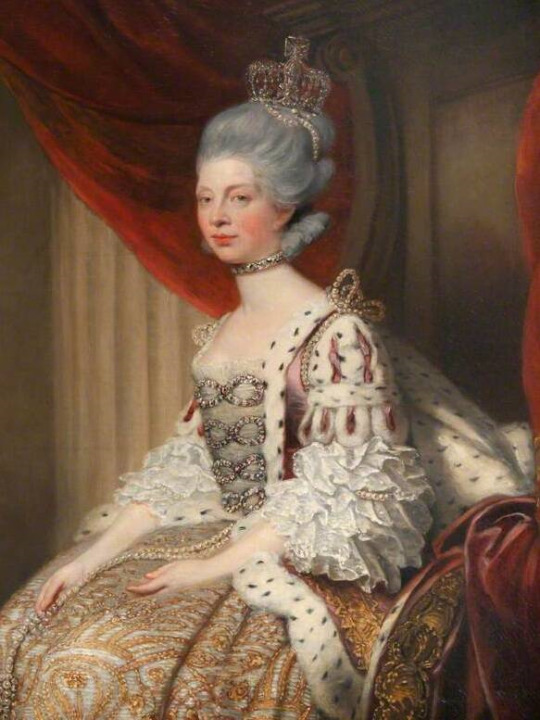

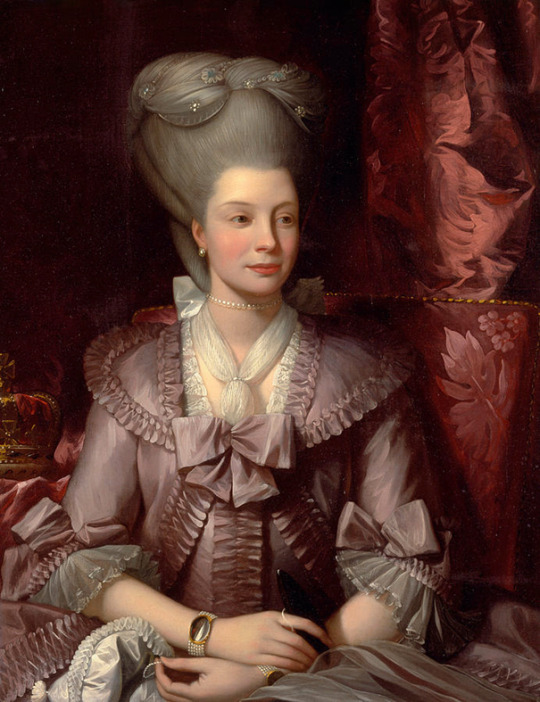
In these pictures she does not look black in the slightest, indeed I’d say her eyes and eyebrows look very light even, nor do her nose and lips, so often critiqued, look big, as was claimed.

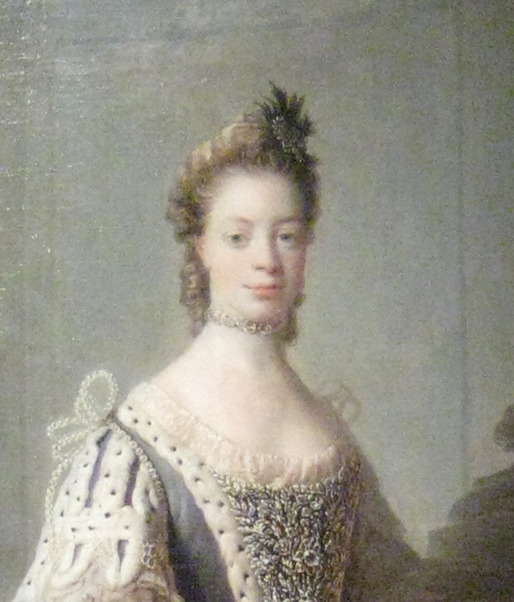
Here we can see her nose looks a bit wider, and her lips a bit bigger. But is that really a convincing argument? Although certain features are more common to a certain race, they are not monopolized by one. Black people can have light hair and light eyes. It is unlikely, but it is possible. It’s just as possible for white women to have bigger lips, a wider nose, a rounder face and even… though rarely, there are white people who have no black relative they know of, white 4a hair. I’ve met a few of them. What I also want to note is that Queen Charlotte’s natural hair could have been crimped and combed until it stood upright and was stiff with powder, as was the fashion back then. It would give her hair a more frizzy look. In the picture underneath it, you can see her hair in fashionable artificially made curls that wouldn’t work on natural type 3 or 4 hair.
However as I said before, I’m not fond of using paintings as proof since they were made-by-demand. Painters would starve if they painted their patrons unflatteringly. There are black people, indeed, even black nobles, ex-slaves, diplomatic ambassadors who had themselves painted with a dark skin colour since the Middle Ages. You can even see the distinction between people of darker-skinned sub-Saharans and North African descent in these pictures. And painters certainly knew how to paint black people for centuries (see: "The Image of the Black in Western Art" by Harvard University Press and “Revealing the African presence in Renaissance Europe”). One such example a noble who did have black heritage was Alessandro de Medici who was nicknamed “the Moor”. Moors referred to black Islamic people. His mother was Simonetta da Collevecchio, a servant of African descent. In this case the argument that many Italians are dark of complexion and have dark hair cannot be used to explain his appearance. If other Italians thought he looked like them, they wouldn’t have paid such attention to his looks because they would have deemed it normal. I’m using 3 paintings of him by 3 different artists. The first picture really is ambiguous, it is only by combining all three that we can say that yes, his looks do fit the bill. If we only had the first picture, would we really be confident to claim him? This goes to show that you can’t say someone has a certain ethnicity based on one painting.

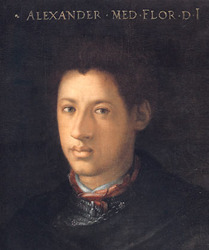

This person was comfortable in his own skin but there were probably just as much, if not many more nobles and wealthy families with mixed blood that had themselves painted white when they were not. Who would disagree? Who would even know? Nine chances out of ten barely anyone who wasn’t from the direct neighbourhood didn’t know what they looked like, and never would. Once the POC died, all that would remain would be a very white looking painting, and no one would know the bloodline had become mixed.
https://www.theguardian.com/world/2017/oct/29/tudor-english-black-not-slave-in-sight-miranda-kaufmann-history
What is, then, a reliable source? An answer, for famous people, is cartoons. Just like we now attach more credibility to a paparazzi picture of Khloe Kardashian than to one of her heavily photoshopped pictures on Instagram, you can trust cartoonists to not try and make people look good. Note: cartoons are always over-exaggerations. Any physical attribute will be enlarged beyond belief for comedic purposes. King George and his wife were often pictured in cartoons. If there was anything very noticeably foreign about Charlotte’s looks, they would portray it. However, what we find is that these cartoons never portray Charlotte as darker than the other people. She wasn’t shown as being black.

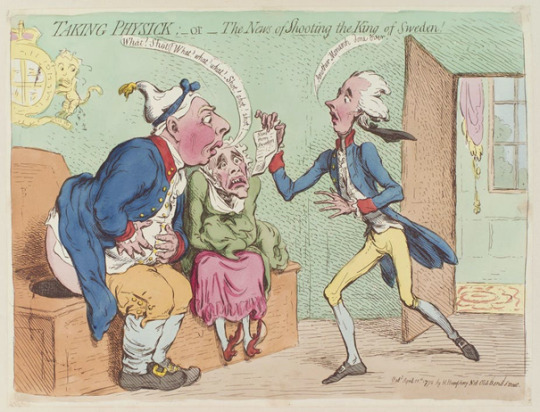
Conclusion:
Queen Charlotte cannot be called black on the basis of her portraits, cartoons or bloodline. If ever there was a trace of black blood in her veins, it was so light it had become undetectable and could not have influenced her appearance. Just ask yourself this question: would you call yourself a certain ethnicity, or claim certain roots, based on one ancestor 200 years in your past? If no, then you also shouldn’t say that Charlotte had black roots or was mixed.
The case of Queen Charlotte does, however, reveal the deeply racist British society of the Georgian Era, which deemed all black physical features ugly, and deliberately used all physical traits associated to the black race as an insult. Keep this in mind, as well as rampant anti-Semitism and hatred for Roma people, every time you read a novel from the time period, or read a tasteless description of a real person from the era. People were cruelly treated based on their heritage, and even if their heritage was purely white, they could be ascribed certain racial features, just because people were racist pricks.
While that’s the unfortunate reality of the time period, I do believe we are allowed to enjoy an alternate reality as an escape, where just for once, race isn’t an issue. So continue on, Bridgerton!
Meanwhile, I’ll be here keeping my fingers crossed for the stories of real black people living in Europe, or black kings and queens in Africa, to be told in a movie or series. The entire world has always existed, it makes no sense for all period movies to keep being focussed on white people in England, Rome and the US.

120 notes
·
View notes
Note
Something I noticed about the way Sonic is portrayed nowadays is that he is pretty much All Might. Colors and Gens didn't have the plot to fully show it and Lost World put all the blame for his actions. Forces however, he keeps the same careless attitude from Unleashed to Gens, everyone looks up for him as their savior and role model and even when he makes bad jokes against the villains he still ends up recking them like trash. He went from Goku/Luffy type of shonen hero to literally All Might.
I barely watch Anime so I have hardly any idea what you’re comparing him too, but let me make it clear:
Sonic’s portrayal in games suffers in localization a lot.
Adventure -> Shadow Portrayal
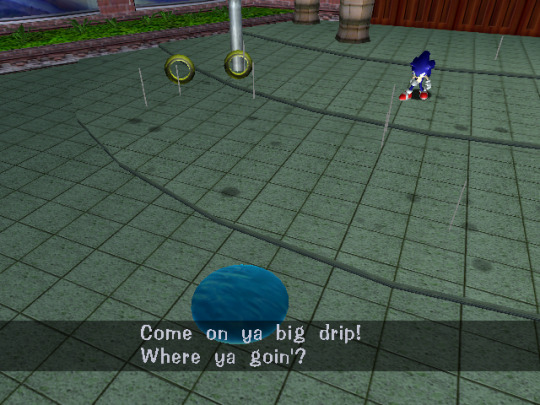
From SA1-06 there was a pretty general issue in the main series with unsatisfactory translations - SHtH messes up a lot of lines, and SA2 is almost completely broken at times (Teria, KAFOW, saying a broken version of the Japanese word for “Damn” when getting grabbed by a ghost)
On top of that I’m not sure what exactly went on and if it’s on purpose or not, but there was some kind of this obsession with giving the character cheesy one-liners, like in the 90s cartoons. Lines like this include “Something Buggin’ you”, “Come and get some Eggman” and “Crack that Eggman wide open”.
Sure, you can argue “Western sonic is different” but look at how that’s turned out in the past, not including giving Classic Sonic a mohawk. I’m sure even those people can notice how much lines like “Something Buggin’ You” are made fun of by people both in and outside of the fanbase. They might have worked well for AoStH and Satam, but they certainly don’t in the main series.
Japanese portrayals of Sonic were far less aggressive than their English counterparts. In fact, he keeps his cool pretty well but boy does he sound pissed in the rare event he actually does get angry. He’s been pretty consistent in acting this way in most, if not all of his appearances. In fact, there’s a character script from SA2 describing the character in exactly this way - you can see it here.
In some cases, this causes the games to lose subtle details like nods to other titles. For example a boy in Station Square who references Little Planet, or Sonic’s reaction to seeing Shadow in Heroes.
Secret Rings -> Black Knight Portrayal
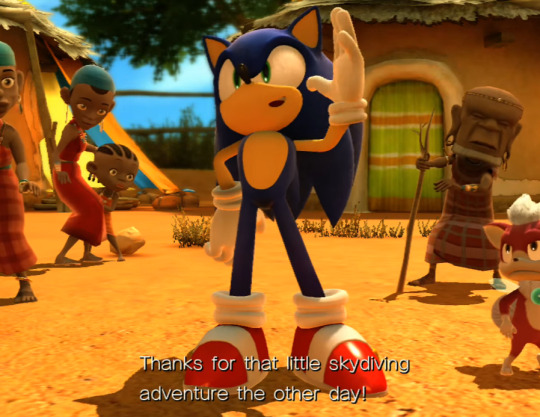
Sonic is a depressed lover boy in 06 IMO. I don’t really want to get into that, so let’s skip that one.
Starting around the time of Secret Rings, Sonic games finally started to get localisations that were pretty accurate in both English and Japanese. There’s a reason the storybooks and Unleashed aren’t brought up nearly as much as the other games are for Sonic saying dumb lines. I mean, there’s still word differences, but they don’t go full on adding in random one-liners.
In fact, the only concern seemed to be the voice actors. For Sonic himself, even though Griffith eventually improved he was still nowhere near what Kanemaru (and that guy who voiced the Werehog, but I guess the decision to not have a seperate VA for that in English isn’t his fault) did for the character. (Unleashed example (J) (E), Black Knight example (J) (E))
Colors -> Lost World Portrayal
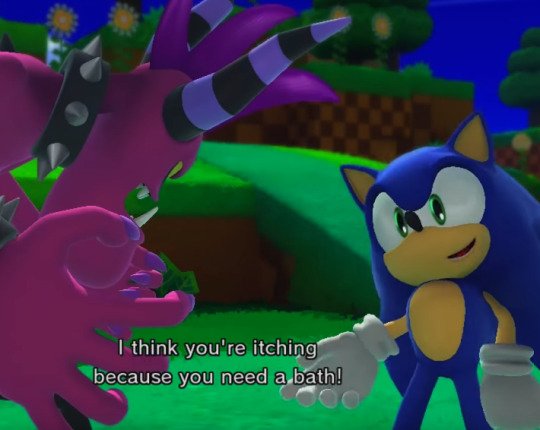
Starting with Colors though Sonic’s character took a weird turn: He was suddenly shouting cheese more than ever, and they were even showing up in the Japanese version. I think this is largely because they suddenly decided to have Sonic games be written in America by people wholly unfamiliar with the franchise. (Though in defense they’re not the entire problem)
The Japanese/English translation was back to being very different as well, mostly because the scripts included many more jokes and puns that couldn’t be translated well between the two. For instance, Cubot is a Cowboy in the English version but he’s a Ninja in the Japanese one. “Baldy Nosehair” is translated as “Mustached Egg” etc.
In the past, there weren’t a lot of lines you couldn’t easily find a way to translate. I think like, the line that got replaced with Ah Yeah This is Happenin’ is one of the only ones I can think of.
While it’s easy to shit on Colors Sonic, I think he did okay speaking for the game itself - it was lighter than the darker games that had been going on for the last 5 years. The problem isn’t that Colors Sonic existed, it’s that they kept him.
Generations got away pretty easy - there’s not much to even write for that after all. The only real change is the Time Eater scene to omit the reference to Dr. Robotnik.
Lost World is where he really falls apart, that game tried to raise the stakes with the planet draining and Tails kidnapping but in the end he just… couldn’t take himself seriously enough.
For some reason, really starting with Lost World the Japanese script took a wild turn. While Colors and Gens were relatively in the same style, Lost World’s Japanese version improved script in that everyone was generally more in-character. Remember what I said earlier about Sonic getting angry? Compare what he says to the Deadly Six when he sees Robo Tails in the English version to the Japanese one.
Even the jokes in Japanese Lost World are more suited to the character than they are in English. Eggman’s Jetpack at the end for example (J) (E). There’s lots of examples of differences in Lost World, too many to sensibly list really.
Forces Portrayal

IMO Forces has largely the same localization problems as SA1 - the lip syncing is always synced to Japanese (though lip syncing has never been good for both languages in one game) and the English script has a bunch of dumb sounding one-liners that get made fun of.
By now I’m sure you’re probably familiar with the whole “Sonic was tortured” and “Tails went mad” thing, but there’s still a lot of bad apples in the English version that aren’t there in the Japanese version.
The scene where Zavok opens Sonic’s prison cell is very different between the two (J) (E). I mean there’s still the problem about being stuck for 6 months, but Japanese Sonic is notably less fixated on butts here. He also doesn’t mention Chilli Dogs in that scene above while fighting him, or that “It’s been Generations” comment when he meets Classic Sonic.
Forces is definitely a step in the right direction for Sonic compared to Lost World though, even in the English version he’s far less quick to make jokes as he was before.
The game even restores an aspect of Sonic that was absent in Colors and Lost World - starting (and even finishing) the game alone. He was getting kinda circlejerky with Tails in those games, whereas in pretty much every major game other than Sonic 2 and 3 he’s always shown doing his own thing separated from characters like Tails and Knuckles initially and meets up with them afterwards - even if it’s a game like Heroes where it happens all at once in the intro movie.
I don’t know how Forces’ script was made, but if Nakamura is saying that the script was passed between Pontaff and Goya with the two making changes, they need to make sure that they both end up with the same result.
Passing the script between America and Japan is fine, but at the end of the day they need to make sure that both sides have scripts that match each other as close as possible, in order to avoid these character and plot inconsistencies.
Either way, by now presumably Pontaff have had more experience with writing for and have more solid past material for this series than the people who localised the SA1-era games. Considering I’ve heard Pontac refuses to talk about Sonic and Graff’s twitter got trashed by angry fans when he announced writing for the game, surely they should be aware of this characterization issue by now, but I don’t blame them if it ends up being something beyond their control, such as a lack of communication between SoA/SoJ or being forced to write the character that way anyway.
I think ultimately what Sonic the character is dealing with right now is the rotting corpse of 90s American Sonic, who died, came back from the dead, then died and came back again - a zombie that won’t stop falling apart, and the stench is catching up.
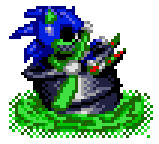
187 notes
·
View notes
Photo

(Originally published on July 27, 2012)
The Dark Knight Rises - The MightyVille Review
The long-anticipated third film in Christopher Nolan’s Batman Trilogy is finally here! The Dark Knight has risen, and MightyVille reviews it to let you know if the film we’ve been excited to see since pretty much the end of The Dark Knight lived up to our high expectations. We try not to reveal many plot spoilers here, but if you want to go into the movie with a completely blank slate, we warn you to click away now...
So, is The Dark Knight Rises worth the years of anticipation? Is it a fitting ending to Christopher Nolan’s trilogy?
YES!
The film is truly outstanding. Excellent direction, amazing action and cinematography, great acting, riveting storyline’s got it all! Who knows? It may even receive Oscar nominations.
But is it my favorite superhero film? No. I prefer my superheroes fun, colorful, and a wee bit more on the family-friendly side. But it’s a brilliant film nonetheless, and for true fans of a darker Dark Knight, it is likely everything they had hoped for.
The Dark Knight Rises begins with some of the most intense and exciting action I have ever seen at the start of a film. Much like the bank robbery scene in The Dark Knight, the opening starts it all off with a bang and gives us a taste of what we can expect from Batman’s foes for the rest of the adventure. When the tale moves next to Gotham City, we get caught up on what has been going on in the eight years that have passed since the previous film’s ending. We are not the only ones who have not seen Batman since then - neither have the citizens of Gotham. Similarly, little trace has been seen of Bruce Wayne, and he has had little involvement in the upkeep of Wayne Manor or running Wayne Enterprises.
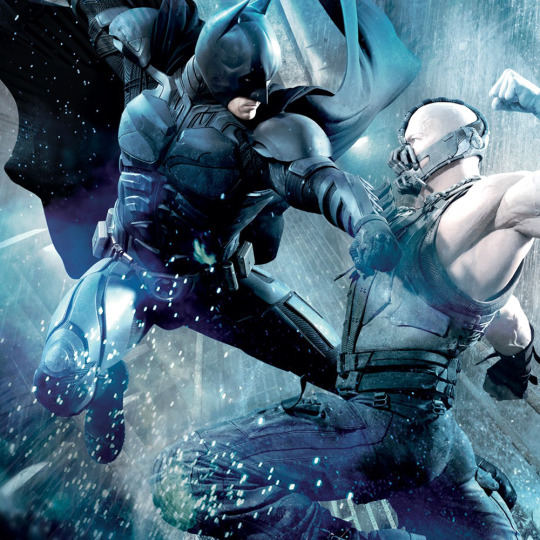
Enter Christian Bale, back to reprise his roles as both Bruce Wayne and Batman. If you enjoyed his performance in the first two films, he won’t disappoint you here. Bale does an excellent job of portraying a Wayne who has atrophied and lost confidence during many years away from his role as Batman. This older, less physically adept portrayal carries over into his part as Batman, who, while still an impressive crime-fighter, may not be as great of a match to his enemies as he was in his glory days. Now, Bale is not my favorite actor to play Batman. I find his Bruce Wayne to be on the dull side and his growly delivery of Batman’s lines to be a somewhat silly. But, I must say that he won my sympathy in The Dark Knight Rises as a Bruce Wayne who somewhat reluctantly returns to his role as Batman because Gotham is in desperate need of their hero.
This less than tip-top version of the Wayne/Batman dynamic seems even more challenged when contrasted with the main villain in the film, the mysterious and monstrous Bane. Despite his mask-filtered voice that occasionally bordered on comedic (my husband, MightyVille’s own Joe Kach, compares it to Adam Sandler’s character Opera Man), I found Bane to be a credible and petrifying villain. He is of the most frightening kinds of villains: strong, fearless, confident, HUGE, and with absolutely nothing to lose. Due to his tortured past, he brings depth to his villainy through his personal understanding of how fear, despair and hope can affect people. His expressed intention to bring down the rich and lift up the people of Gotham is also poignant to the current times and makes it believable that some of Gotham’s citizens would follow him rather than be repulsed by him. All in all, Tom Hardy proves himself to be an extremely talented actor, able to express so much despite most of his face being covered by a mask. He’s also quite a terrifyingly large, muscular specimen of a man.
At times in the film, it seems that it will be impossible for Batman to save Gotham from the destruction that Bane and other villains have planned. But in many ways, this is not just a film about Batman, but about the citizens of Gotham, rising up to save their city with the help of a masked hero. Gary Oldman is back as Commissioner James Gordon, and we are also introduced to another devoted Gotham City copper, John Blake, played by Joseph Gordon-Levitt. Gordon-Levitt puts in a solid performance as Blake, your average “good cop” hero who’s faith in Batman never waivers. I wondered at times why so much focus and screen time was being given to this character, but this question was resolved by the end of the film. Marion Cotillard as Miranda Tate also jumps into the action at times. She also seemed to receive too much focus at first, but the importance of her role was ultimately made clear.
And then, of course, there’s Ann Hathaway as Catwoman! She is a Selina Kyle like no others seen on screen, and is effective in making the character her own. Hathaway’s Catwoman is a sly, slinky, self-reliant woman who is as jaded and opportunistic as most of Gotham residents. She is neither bad nor good, but instead is doing what it takes to survive in her urban habitat, much like a cat. “I’m adaptable,” she declares. Hathaway is believable as an efficient “cat” burglar that is capable of getting what she wants when she wants, as well as holding her own in a fight. Her “cat” suit is less a costume than an effective tool for pulling off the most challenging of thefts. Hathaway has revealed in interviews that she based her portrayal primarily after the Felonious Female of the comics, rather than mimicking previous onscreen versions, and she succeeds in making this Catwoman more recognizable to lovers of the DC Comic.
The only character who let them me down in the film was Alfred. I had heard he had an expanded role in The Dark Knight Rises, but it seems that all he does in this film is cry and pout about his disagreement with the idea of Batman returning. I was really turned off by his consistent blathering about wanting to protect Wayne. He seemed to be taking his role as a father figure too far, and I wondered where he lost his British stiff upper-lip. This is not to fault Michael Caine’s acting, which was good as usual, but more the way the character was written.
That being said, the writing for The Dark Knight Rises overall is spectacular, with a script handled by Johnathon Nolan and David Goyer. The story is very well put together and thought out, with a number of exciting plot twists to thrill us by the end of the film. The action is amazing, from football field explosions to airplane crashes to gargantuan mob fight scenes. Batman shows up at all the right times, and each time the effect is exhilarating, with the music and cinematography working in unison. We’re also finally exposed to Nolan’s version of the Batcave, and Batman’s new “toy”: “The Bat” hovercraft is awe-inspiring. Even the well-timed return of the Batpod cycle and the Bat-Signal were spectacular, providing as much hope to the audience as they did to Gotham’s residents.
Finally, much has been said and speculated about the ending to this film. For me, this was the perfect ending to the film, as well as the trilogy. In fact, it is one of the best endings I have seen to any film. I love that the ending doesn’t try to answer every question and tie up each loose end, but instead sends the trilogy off with a proper goodbye and a glimpse at what the future may hold for some of the characters. I don’t want to give away too much, but I can’t remember the last time I saw so many grown men cry at the end of a movie.
The Dark Knight Rises is not perfect, but it comes near. This is an excellent film that shouldn’t be missed. It has unfortunately received a lot of negative press due to the horrifying shootings that occurred in an Aurora, Colorado midnight opening. As someone who is sensitive to violence in films, I was actually impressed with the way Nolan handled the violence in this movie, with most scenes taking a more classic approach in which the violence is implied rather than shown in every gory detail. I hope that people can disassociate the acts of a mad man from this film that was made for peaceful reasons and actually encourages society to move in a more peaceful and caring direction. The Dark Knight Rises provides a message of hope in dark times, and, in light of recent events, that is something we all need.
The Dark Knight Rises:

Have you seen the final film in the Dark Knight Trilogy? Agree with our review? Or agree to disagree? Let us know!
#mightyville#review#news#batman#thedarkknight#thedarkknightrises#thedarkknighttrilogy#dccomics#warnerbros#christophernolan#comics#comicbooks
0 notes